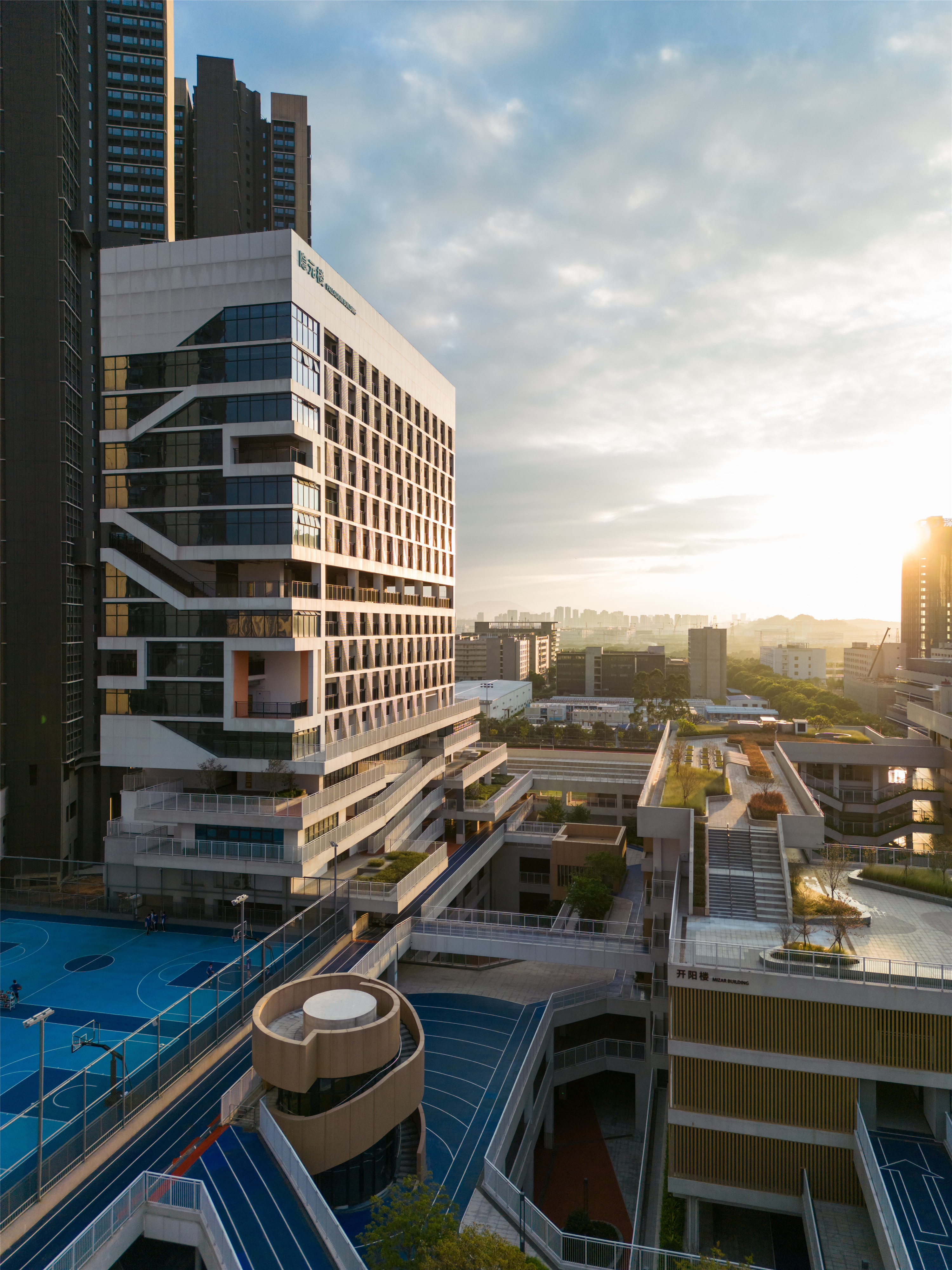
设计单位 申都·湾创
项目地点 广东深圳
建成时间 2022年9月
建筑面积 104,107.62平方米
本文文字由申都·湾创提供。
本次设计实践利用空间手段重新定义学习与成长的关系:成长功能单元向心汇聚,亦乐亦学中的空间重构实现平衡,这是一座平衡孩子成长需求与教学需求的创新式校园。
This design practice uses spatial means to redefine the relationship between learning and growth. The growth functional units converge towards the center, and the spatial reconstruction in Yile Yixue achieves balance, creating an innovative campus that balances children's growth needs and teaching needs.
项目位于坪山区坑梓街道金沙社区亚迪三村南侧,项目总用地面积32400.00平方米,总建筑面积104107.62平方米。该地块毗邻聚龙生态公园,地形开阔。学校旨在创造更亲近自然与开放的教学环境,为城市贡献一片绿色。营造富有活力的艺术纽带,为师生提供有机生长的校园空间。
This project is located on the south side of Yadi San Village, Jinsha Community, Kengzi Street, Pingshan District, with a total land area of 32400.00 square meters and a total construction area of 107000 square meters. The plot is adjacent to Julong Ecological Park and has an open terrain. The school aims to create a more natural and open teaching environment, contributing a green landscape to the city. Create a vibrant artistic bond and provide an organic campus space for teachers and students to grow.
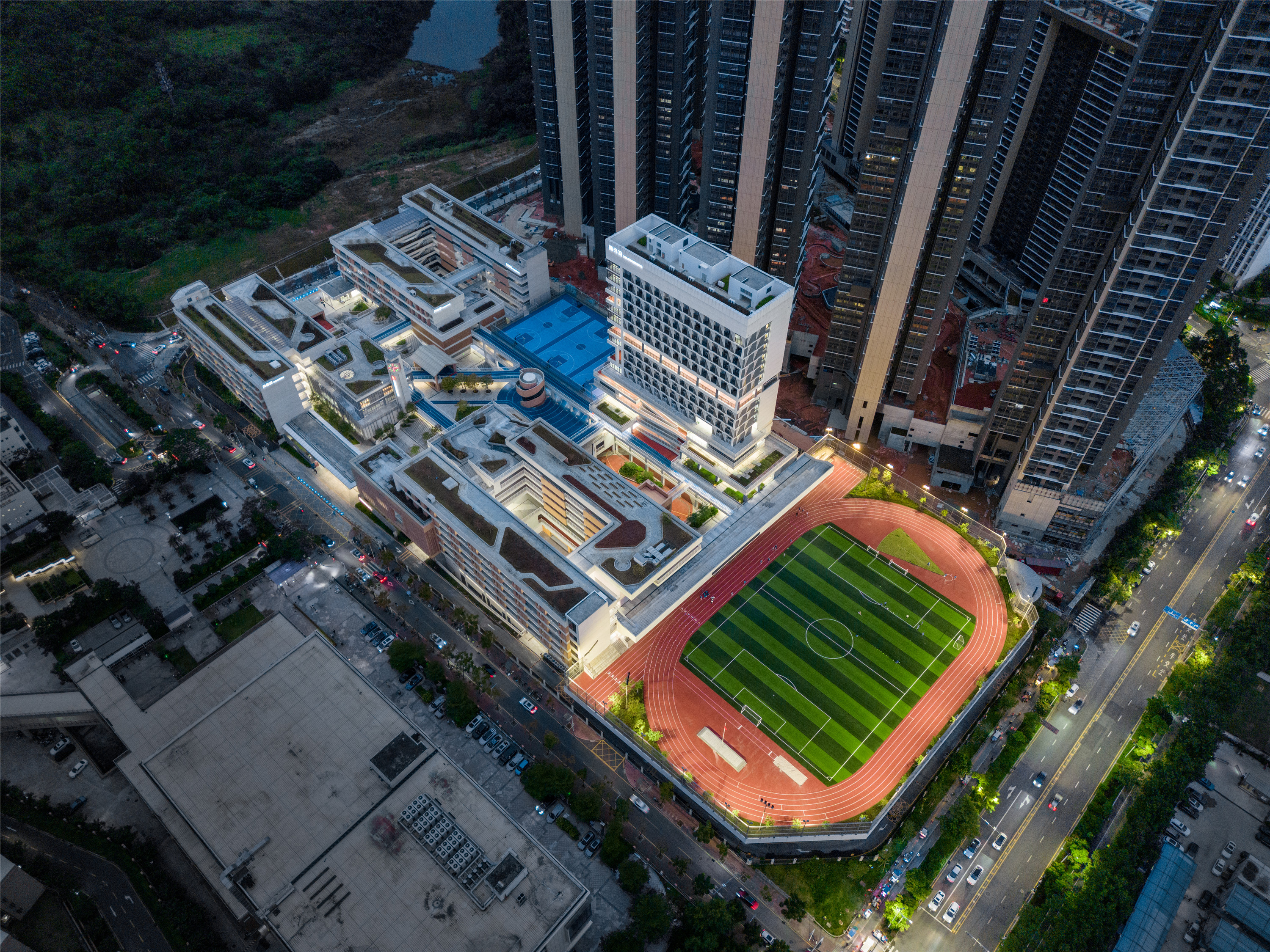
起 — 活力绿洲
活力绿洲——校园成为自然、城市、成长的时空交汇,是此次设计的主要设想。作为一次建筑设计实践,设计概念在落实的过程中遇到了方方面面的困难:南北皆为高层及超高层住宅区,用地紧张背景下的高密度、场地的巨大高差、周围环境的干扰……场地特征与环境现状都给设计带来了巨大挑战。
The main idea of the design is to create a vibrant oasis where the campus becomes a natural, urban, and growing intersection of time and space. As an architectural design practice. In the process of implementing the design concept, various difficulties have been encountered: both the north and south are high-rise and super high-rise residential areas. In the context of tight land use, high-density challenges, huge height differences in the site, and interference from the surrounding environment have brought huge challenges to the design due to the characteristics of the site and the current environmental situation.

将困境化为意境,不仅是对设计要求的回答更是对使用者的关怀,更要求为城市带来一座具有呼吸感的空间绿洲,师生沉浸其中,闹市中尽享自然。
Transforming difficulties into artistic conception is not only an answer to design requirements but also a care for users. It also brings a breathing space oasis to the city, allowing teachers and students to immerse themselves in it and enjoy nature in the bustling city.

再言之,绿洲的设计是对校园建筑本身属性的反思与创新。校园相当于学生学习的容器,这是学校的基本功能,对应学生“身”的需求;但学校又是学生成长时期所处时间最长的场所,所以除了学习之外,我们想附加一些价值在校园中。在这里,他们可以剥离学生的身份,就单纯是个孩子,在这里玩耍、交往。这是对应孩子们“心”的需求,我们希望为之提供一个优美环境,让学生在离自然最近的地方学习。
In other words, the design of oases is a reflection and innovation on the inherent attributes of campus architecture. The balance between learning and growth, the spatial needs of campus owners in the process of identity transformation, and the attitude and choice of architecture returning to its true nature are the spatial machines that satisfy the physical and mental needs of users.
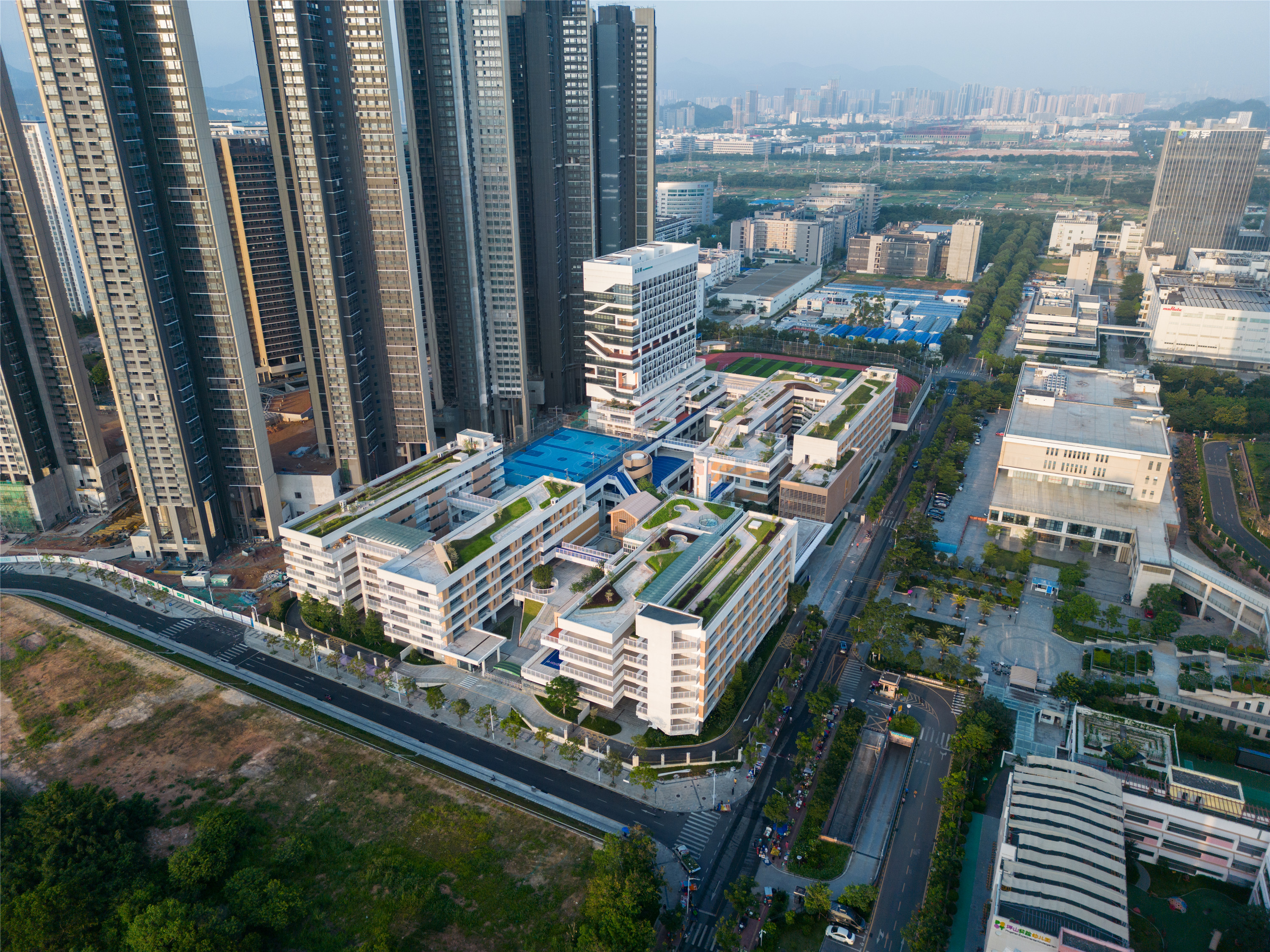
聚 — 有机整体
“一个资源中心,两个教学组团,三个相关配套”规划布局应运而生,各区独立又联系从空间形式上实现成长与学习功能的对立统一的有机体。建筑空间相关成长功能向拓扑中心聚合,形成分级、多元的空间体系,让学生在多功能的行为发生器中自在成长。
The planning and layout of "one resource center, two teaching clusters, and three related supporting facilities" has emerged, with each district being an independent and interconnected organic entity that achieves growth and learning functions in spatial form. The growth functions related to architectural space converge towards the topological center, forming a hierarchical and diverse spatial system, allowing students to grow freely in a multifunctional behavior generator.
中心建筑分别是四种不同功能的空间,向内通过共享聚合,向外链接协同不同功能实体,办公、食堂、图书馆、资源中心都与使用者实现了空间上的聚合。资源共享中心位于场地东北侧,宿舍及配套用房为与场地中部南侧,与两个教学单元互为对角关系,方便两个教学单元同时到达。聚合的成长空间体系包含环形跑道、休息厅、画廊、图书角,塑造了更友好的外部空间。
The central building consists of four different functional spaces, which are aggregated internally through sharing and linked externally to collaborate with different functional entities. The office, cafeteria, library, and resource center all achieve spatial aggregation with users. The Resource Sharing Center is located on the northeast side of the venue, with dormitories and supporting buildings located on the south side of the central part of the venue, forming a diagonal relationship with two teaching units to facilitate simultaneous access. The aggregated growth space system includes a circular runway, lounge, gallery, and book corner, shaping a more friendly external space.

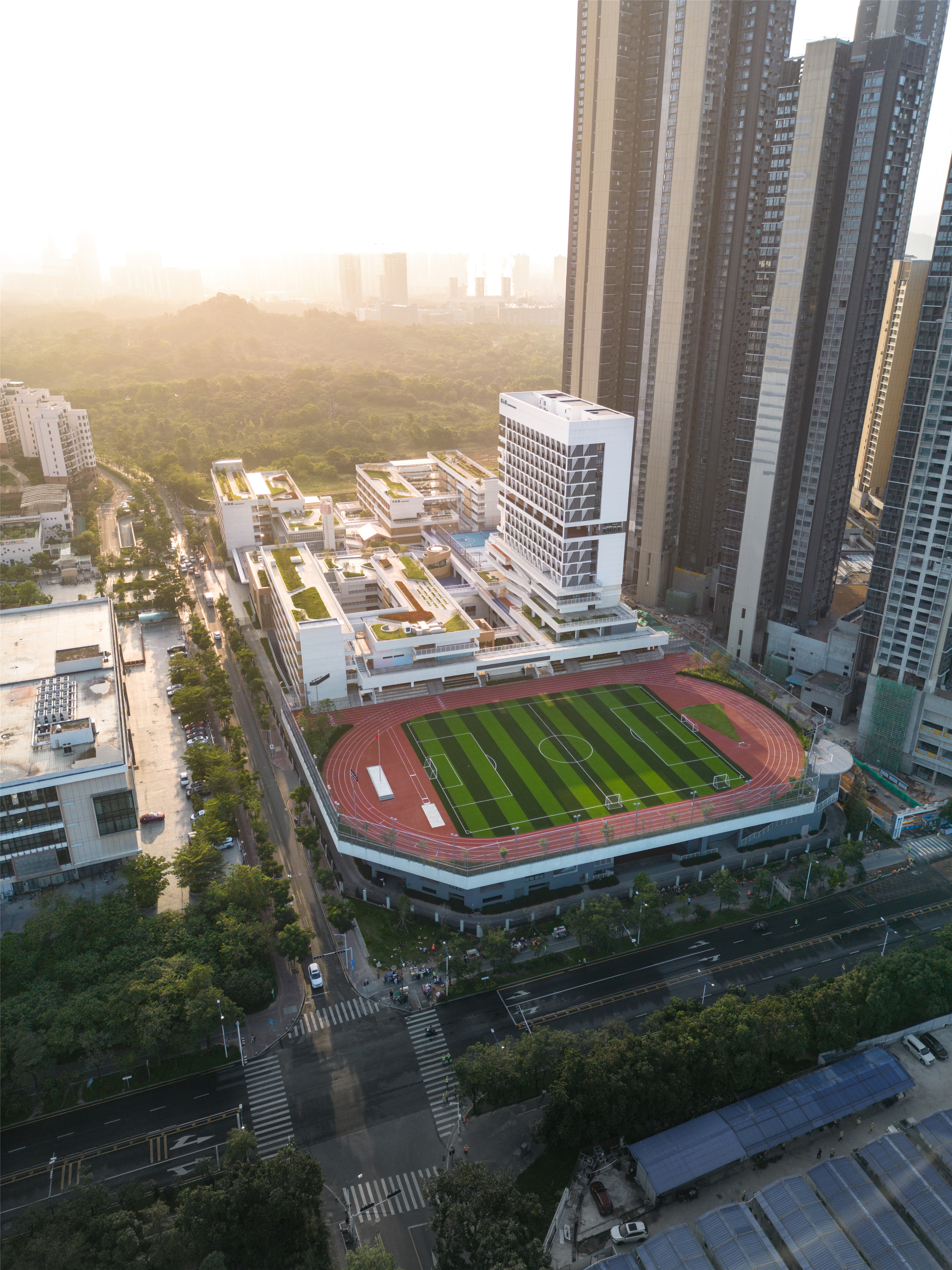
思 — 亦乐亦学
“学习好也要成长好”,学校不仅是教书育人的空间机器,也承载着父母对与孩子成长的期盼,对于使用的主人公来说,他们不仅是勤奋的学生,也是自由的孩子。校园空间面对双重功能的挑战应该作出积极回应,成为教育与成长平衡的契机。
School is not only a space machine for teaching and educating, but also carries the expectations of parents for their children's growth. For the protagonists who use it, they are not only diligent students, but also free children; Campus space should respond positively to the challenge of dual functionality and become an opportunity for balancing education and growth.
传统的校园是教学的空间集合体以充分发挥教育的职能,本次设计实践通过设强化校园的内部成长功能,将成长空间上升到与学习空间同样重要的位置,给孩子学习之外提供了亲近自然的空间序列。校园不仅仅是课堂生活,更是成长的绿洲。
The traditional campus is a collection of teaching spaces to fully play the role of education. This design practice strengthens the internal growth function of the campus, elevating the growth space to an equally important position as the learning space, providing children with a space sequence that is close to nature outside of learning. Campus is not only classroom life, but also an oasis of growth.
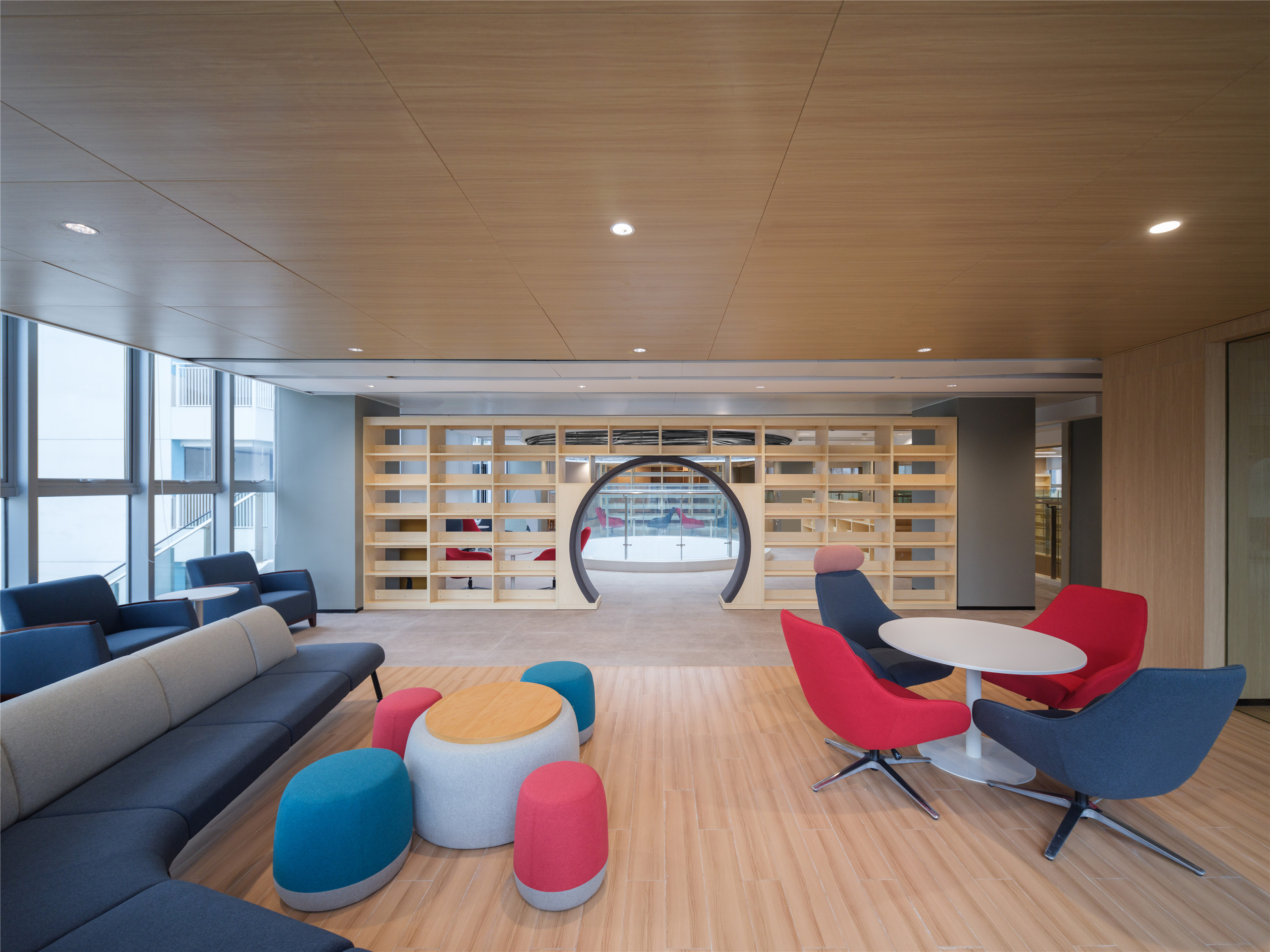



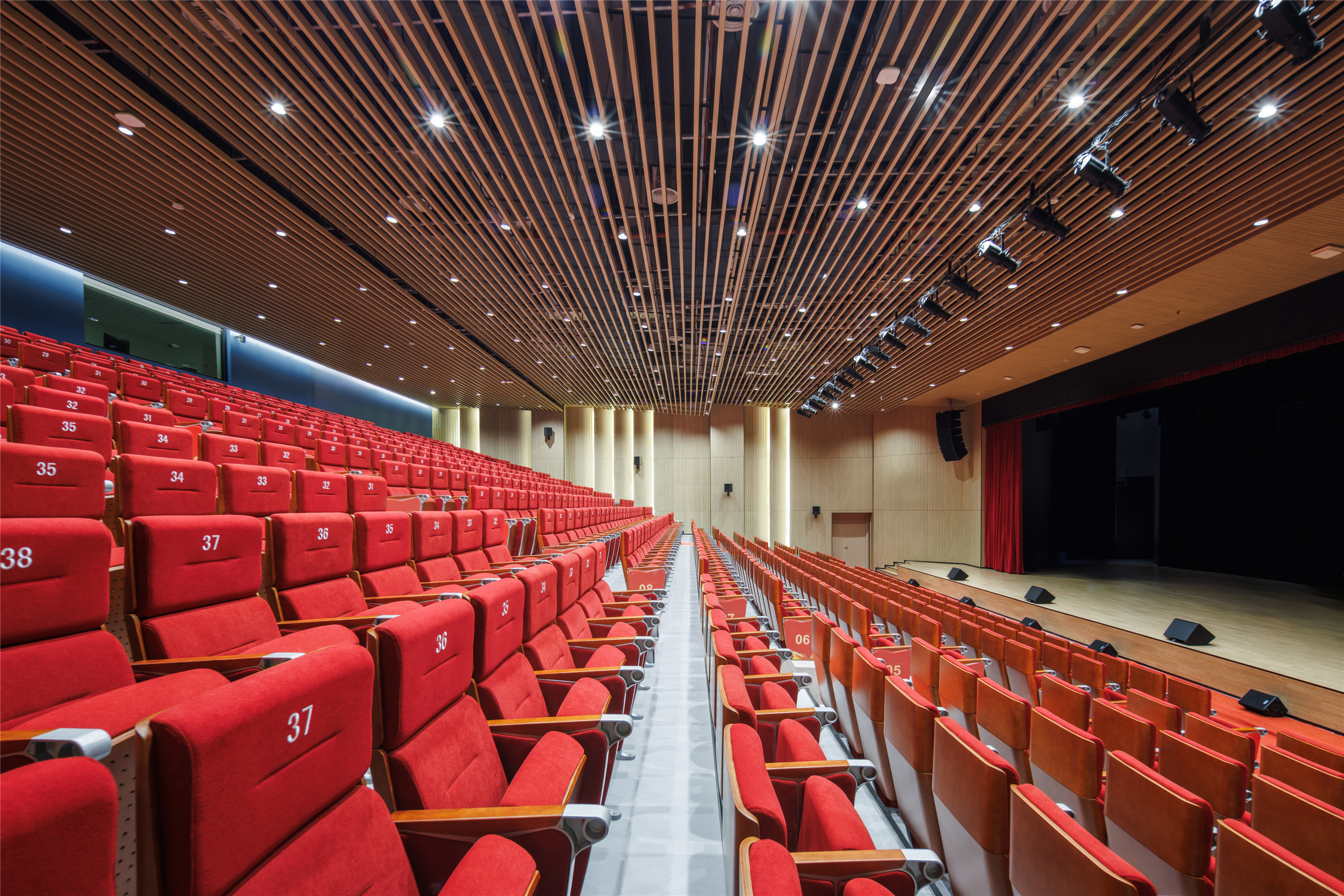
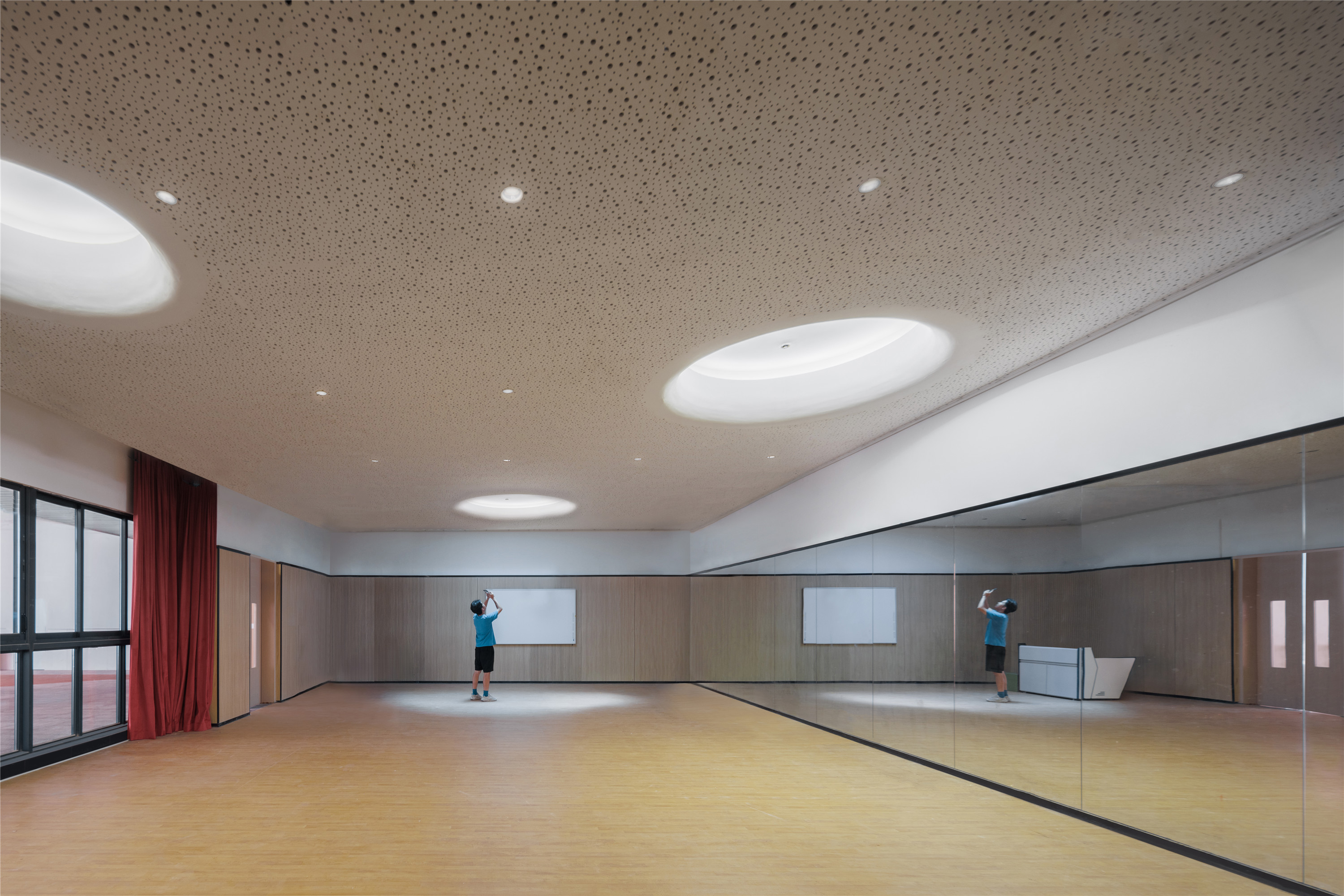
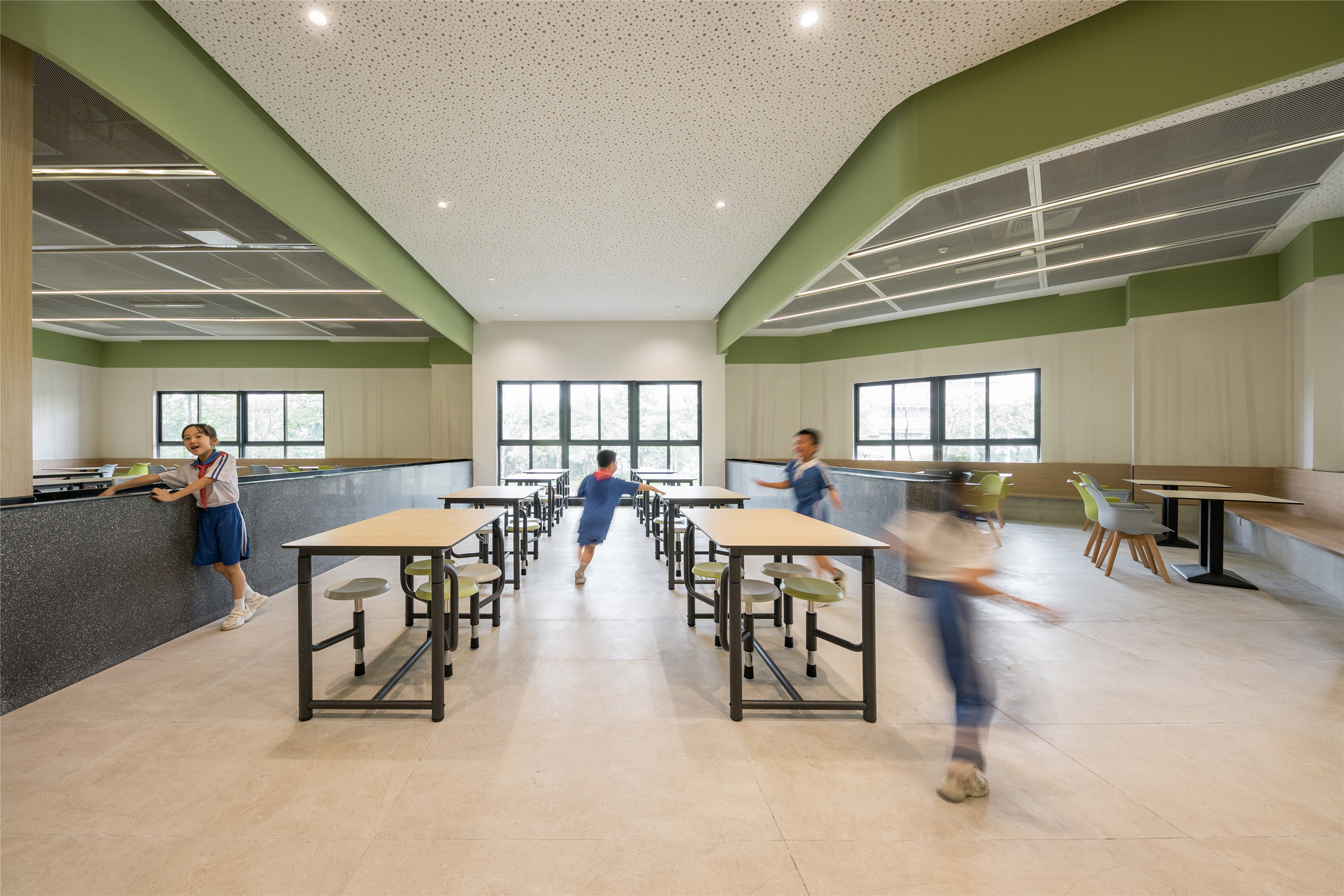
场 — 起伏绿洲
基地东西狭长,高差大的现状条件是很大难题,建筑师巧妙利用场地东北高、西南低的高差关系,提出了双首层设计理念,给学生丰富校园空间,同时在工程上减少土方开挖。
The current situation of the site being narrow and long from east to west with a large height difference is a great challenge. The architect cleverly utilized the height difference relationship between the northeast and southwest of the site to propose a double first floor design concept. Enriching campus space for students while reducing earthwork excavation in engineering.
空中运动场和体育馆等大场馆放置在场地西侧,有效规避西侧主干道对教学单元的影响,同时为师生提供敞开式的运动空间,保证其享有充足的阳光和日照。
The air sports field and gymnasium are placed on the west side of the venue, effectively avoiding the impact of the main road on the teaching unit on the west side and providing open sports space for teachers and students, enjoying sufficient sunlight and sunshine.
人性化的校园界面也是建筑城市友好性的体现,运动场靠近城市道路布置,削减车辆噪音对学校影响,同时减小对城市道路的压迫,营造良好的城市界面。
The humanized campus interface is also a reflection of the building's urban friendliness. The sports field is arranged close to urban roads to reduce the impact of vehicle noise on the school, while reducing the pressure on urban roads and creating a good urban interface.
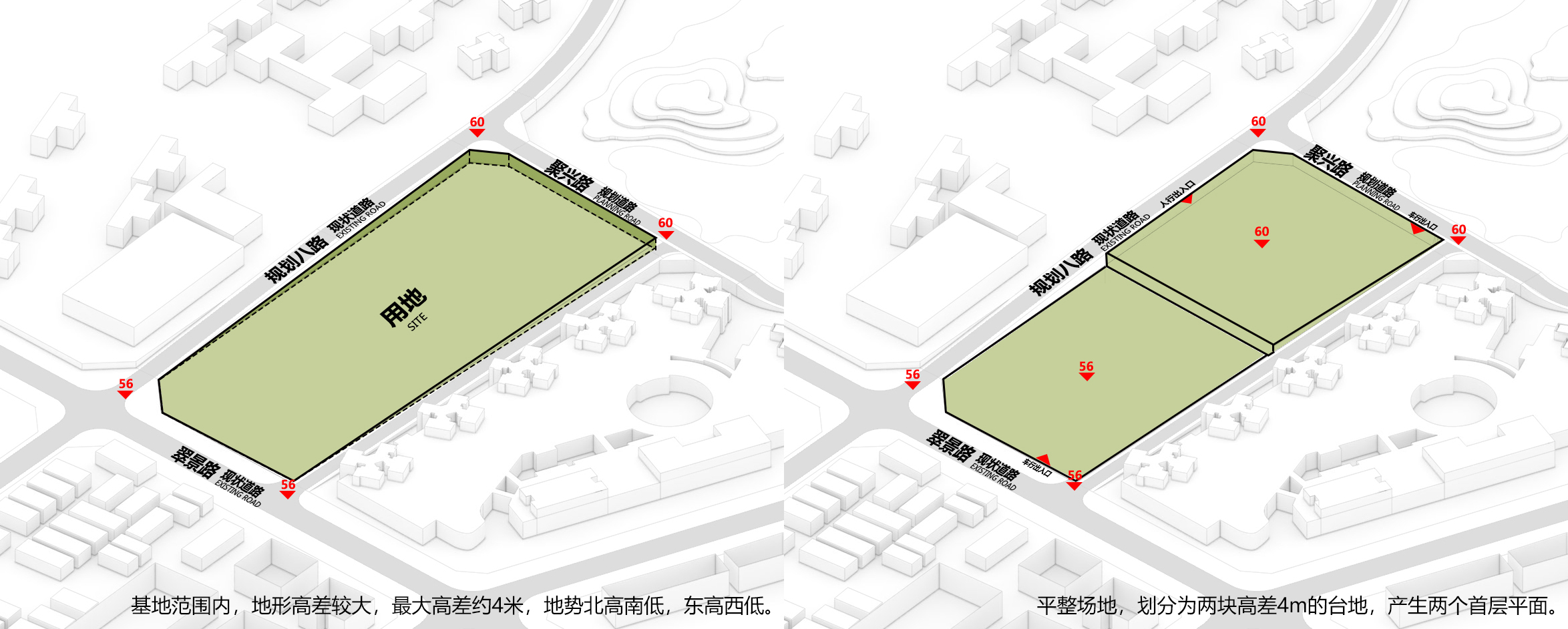



声 — 绿洲洞天
良好的建筑声环境是成长与学习的基础。校园内外展现初不同的空间氛围,书声、叶声、鸟声交织,让学生在其中能拥有幽静的学习氛围,免受城市的喧嚣。
A good architectural sound environment is the foundation for growth and learning. The campus presents a different spatial atmosphere both inside and outside, with the sounds of books, leaves, and birds intertwined, allowing students to have a quiet learning atmosphere and avoid the hustle and bustle of the city.
场地西面为工业区,避免噪音干扰,平衡环境与内部功能是设计之初需要解决的问题。设计用东西轴线贯穿场地,有效利用东面景观的同时尽量回避工业区噪音。种种巧妙的设置校园内部景观,也为使用者营造沉浸式的空间声学体验。
To the west of the site is an industrial area, avoiding noise interference and balancing the environment and internal functions are issues that need to be addressed at the beginning of the design. The east-west axis runs through the site, effectively utilizing the eastern landscape while avoiding industrial noise as much as possible. Various clever settings of the campus interior landscape create an immersive spatial acoustic experience for users.

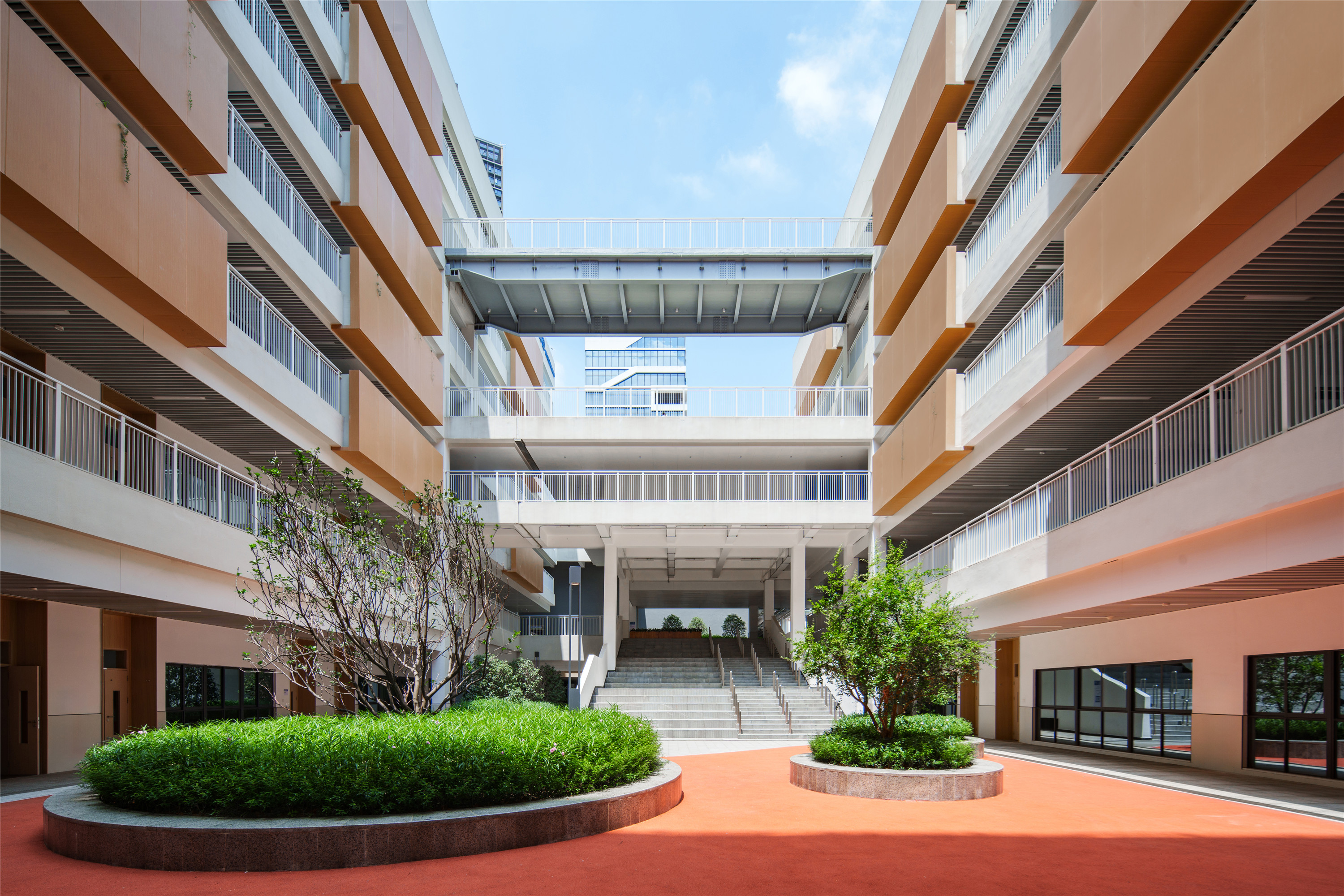
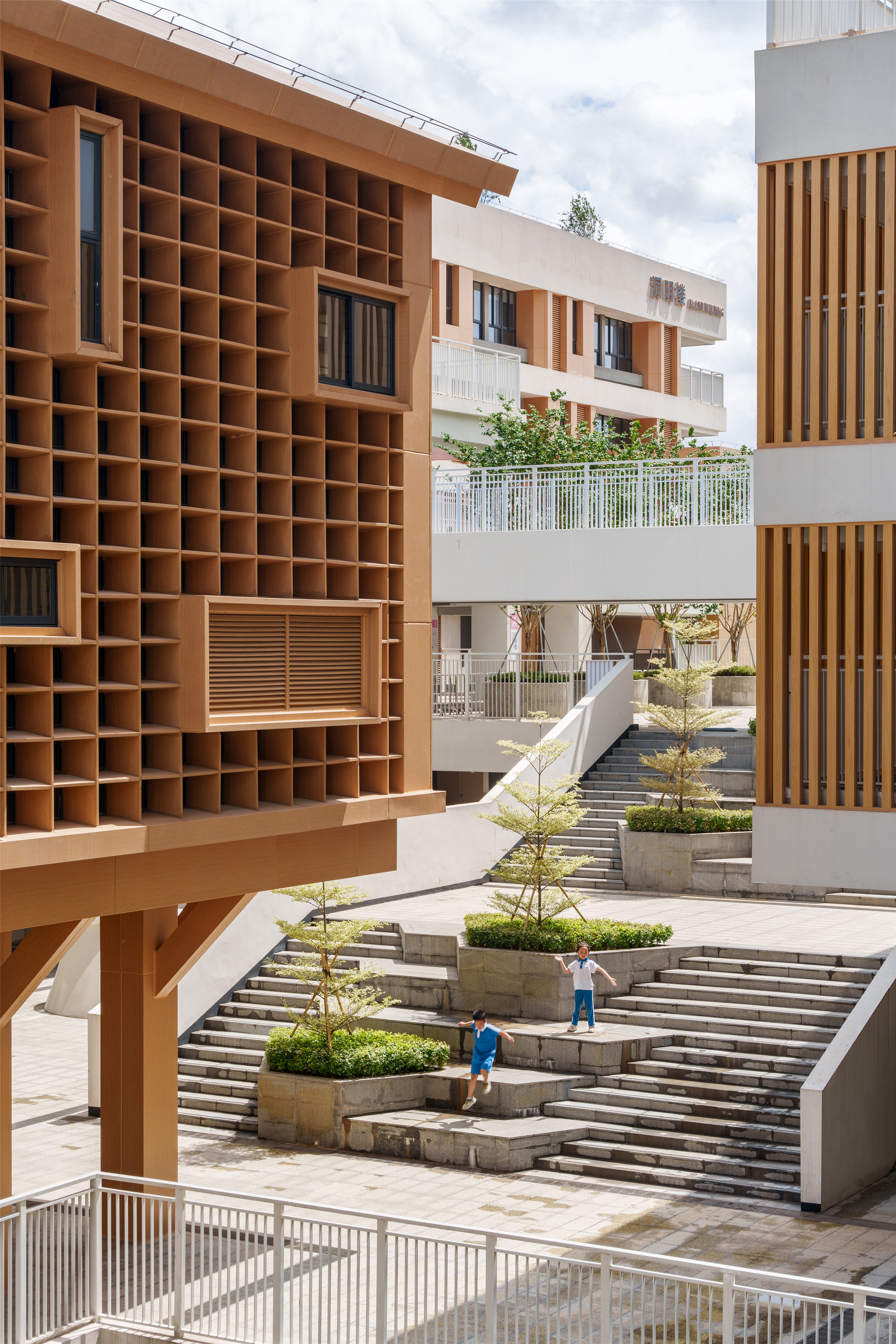
光 — 光影绿洲
校园在解决场地采光的同时,也利用光影塑造了独特的空间美学。经过严密的日照分析,场地中部设置运动场,有效化解南侧超高层对场地日照带来的不利影响,保证常规教室与专业教室的光照需求。
打开的校园空间也能获得更多的光影塑造条件,运动场、底层院落、廊道、树木、中央绿洲的空间跟随阳光的轨迹而产生变化,光与空间相互融合,校园内部既拥有舒适光照条件,同时也能充满对影子空间的需求。光影变换的美学设计,在此表现得淋漓尽致。
The campus not only solves the problem of site lighting, but also shapes a unique spatial aesthetics through the use of light and shadow. After rigorous sunlight analysis, a sports field was set up in the middle of the venue, effectively resolving the adverse effects of the southern super high-rise on the venue's sunlight and ensuring the lighting needs of both regular and professional classrooms. The open campus space provides more conditions for shaping light and shadow. The spatial changes of the sports field, lower courtyard, corridors, trees, and central oasis follow the trajectory of sunlight, and the integration of light and space is designed. The campus interior has comfortable lighting conditions while also being filled with the demand for shadow space. The aesthetic design of light and shadow transformation is fully demonstrated here.

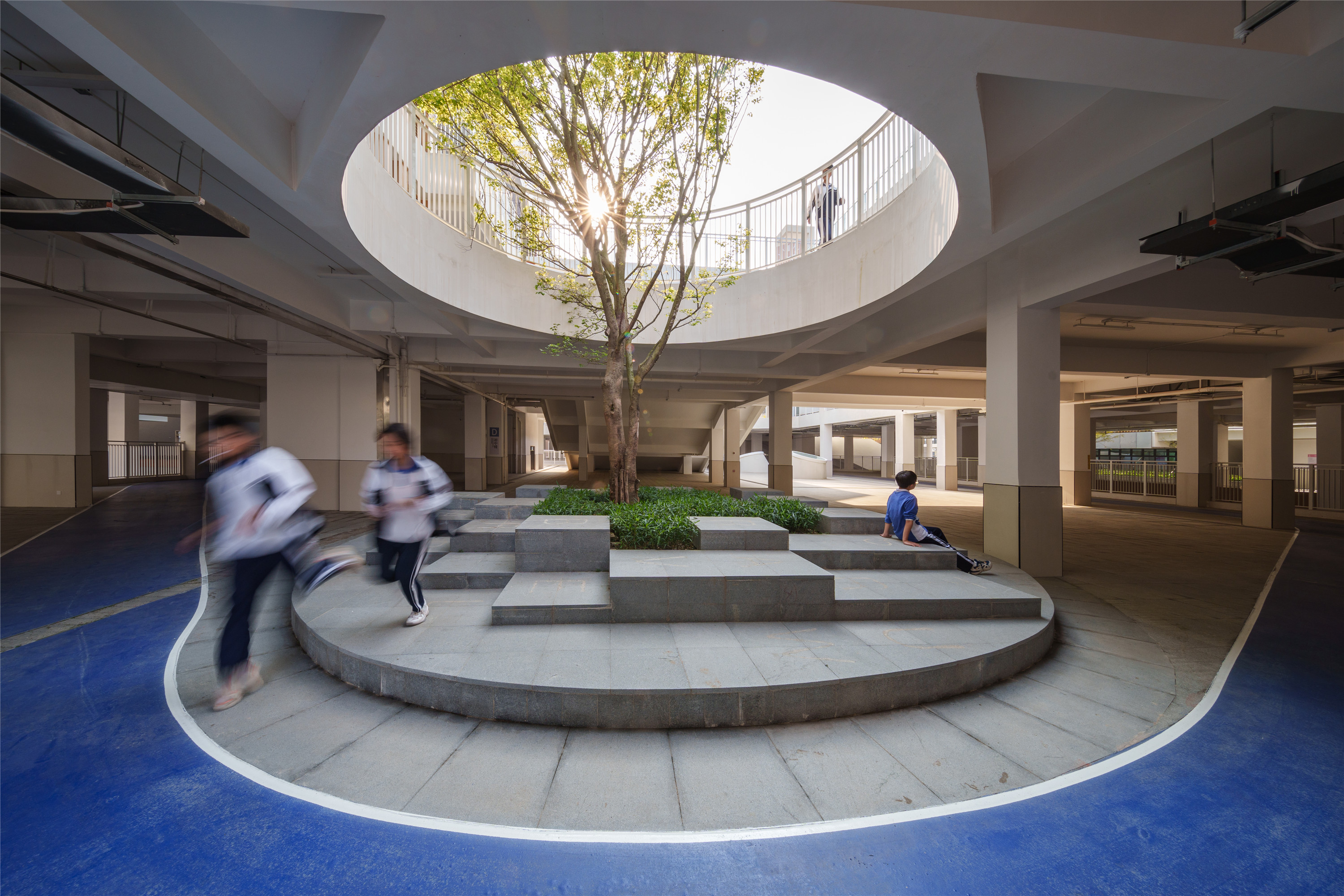
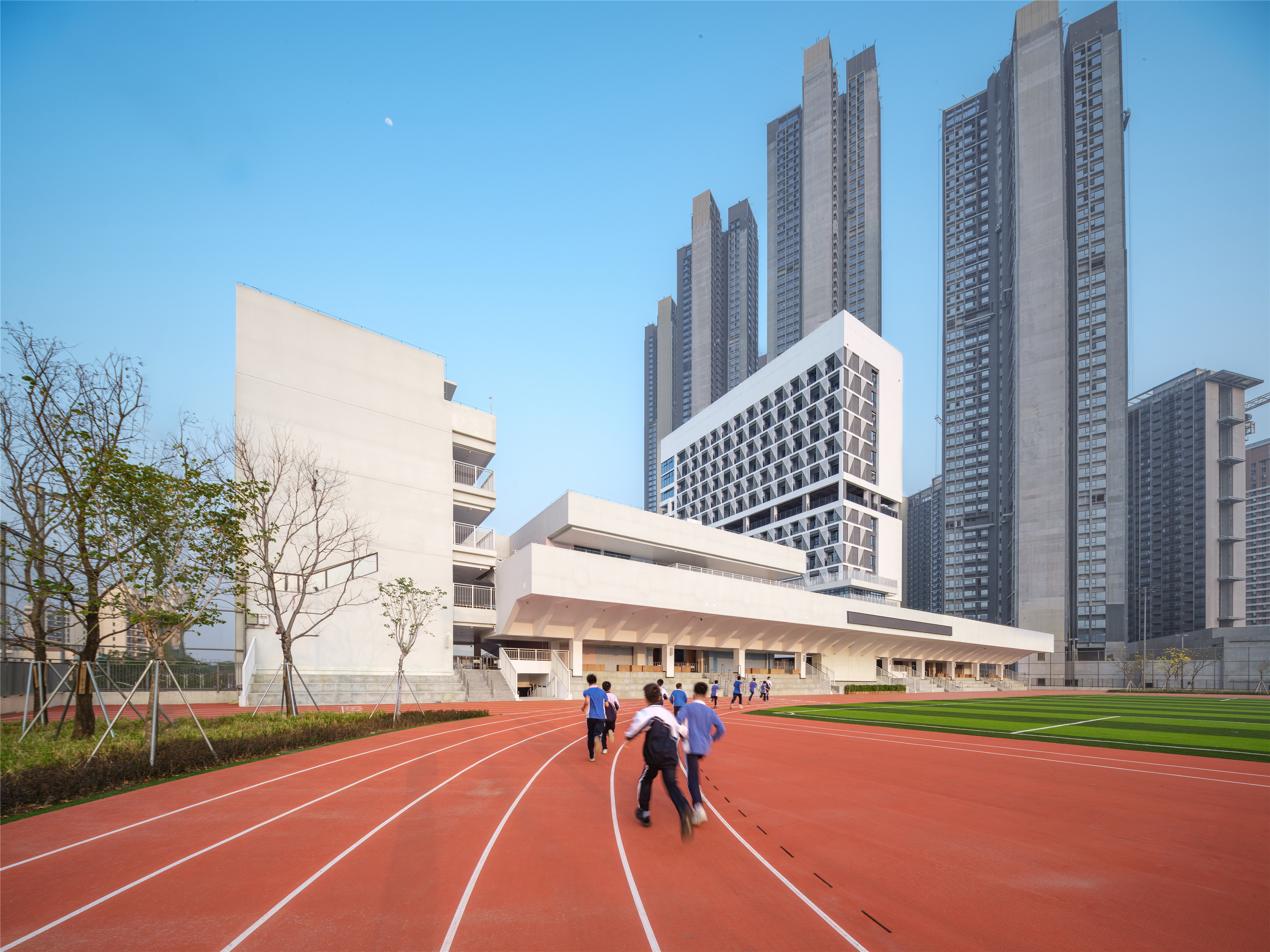
景 — 曲径之洲
漫游在校园,其自然景观不仅包含了内部秩序,也是建筑对于场地记忆的延续。场地东侧为聚龙山公园,如何最大化的利用现存的景观资源?——
Roaming in the landscape space of the campus, its natural landscape not only includes internal order but also the continuation of the building's memory of the site. How to maximize the utilization of existing landscape resources in Julongshan Park on the east side of the site——
引景:为了尊重场地原有记忆,校园主动引景入内,向东设置开放空间,形成空间上的延伸与关联;
In order to respect the original memory of the venue, the campus actively introduces scenery and sets up an open space to the east, forming an extension and connection in space.
观景:聚龙山景色让学生在学习、漫游、运动中皆能感受自然,活力环廊最大化开阔视野,且预留了与公园连接可能性,在未来可以形成山园联动,校城联通;
"Viewing", the scenery of Julong Mountain allows students to experience nature for learning, roaming, and sports. The vitality of the corridor maximizes the open view, and reserves the possibility of connecting with the park in the future to form a linkage between the mountain and park, connecting the school and the city.
造景:利用设计手段将屋顶、庭院及角落空间打造成景观视觉中心,自然与设计景观融合,观景更宜。
Landscape design utilizes design techniques to create a visual center for the roof, courtyard, and corner spaces, integrating nature with the designed landscape for a more suitable viewing experience.


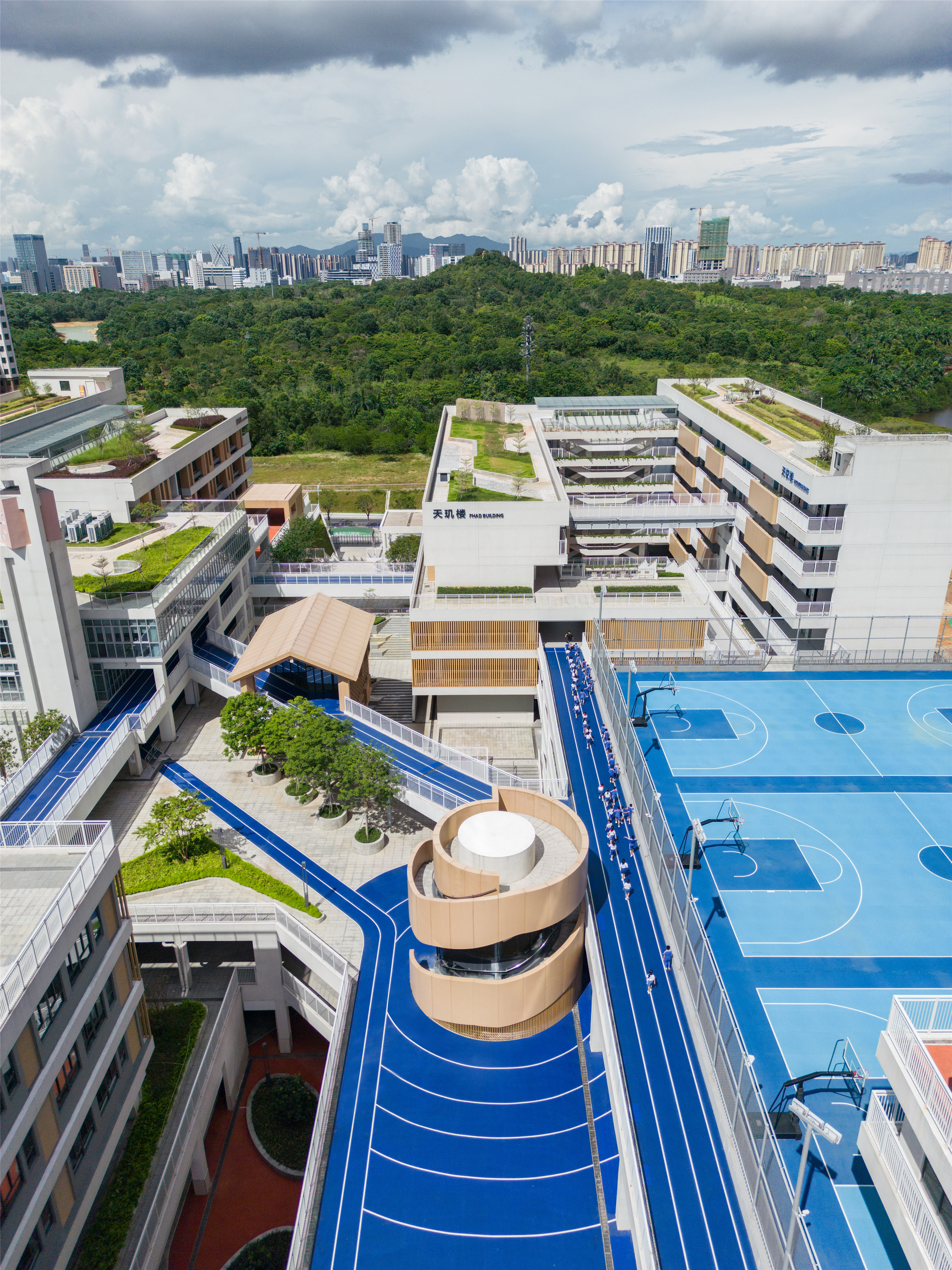
校园内部确立一条线性空间,营造多维、动态、流畅环廊系统连接各大功能区;穿行之间,学生能够感受到自然与空间的交替变换;停留之处,沿途设置图书驿站、科技天地、艺术展厅的趣味节点;角落之中,学校各处散落着图书角、移动书车,图书漂流将整个校园塑造成一座随处皆可阅读的“泛图书馆”。
Establish a linear space within the campus and create a multi-dimensional, dynamic, and smooth corridor system to connect various functional areas; Between walking, students can feel the alternation between nature and space; Set up interesting nodes along the way such as book stations, science and technology fields, and art exhibition halls at the stopping point; In the corners, book corners and mobile book carts are scattered throughout the school, and book drifting shapes the entire campus into a ubiquitous "library" for reading.
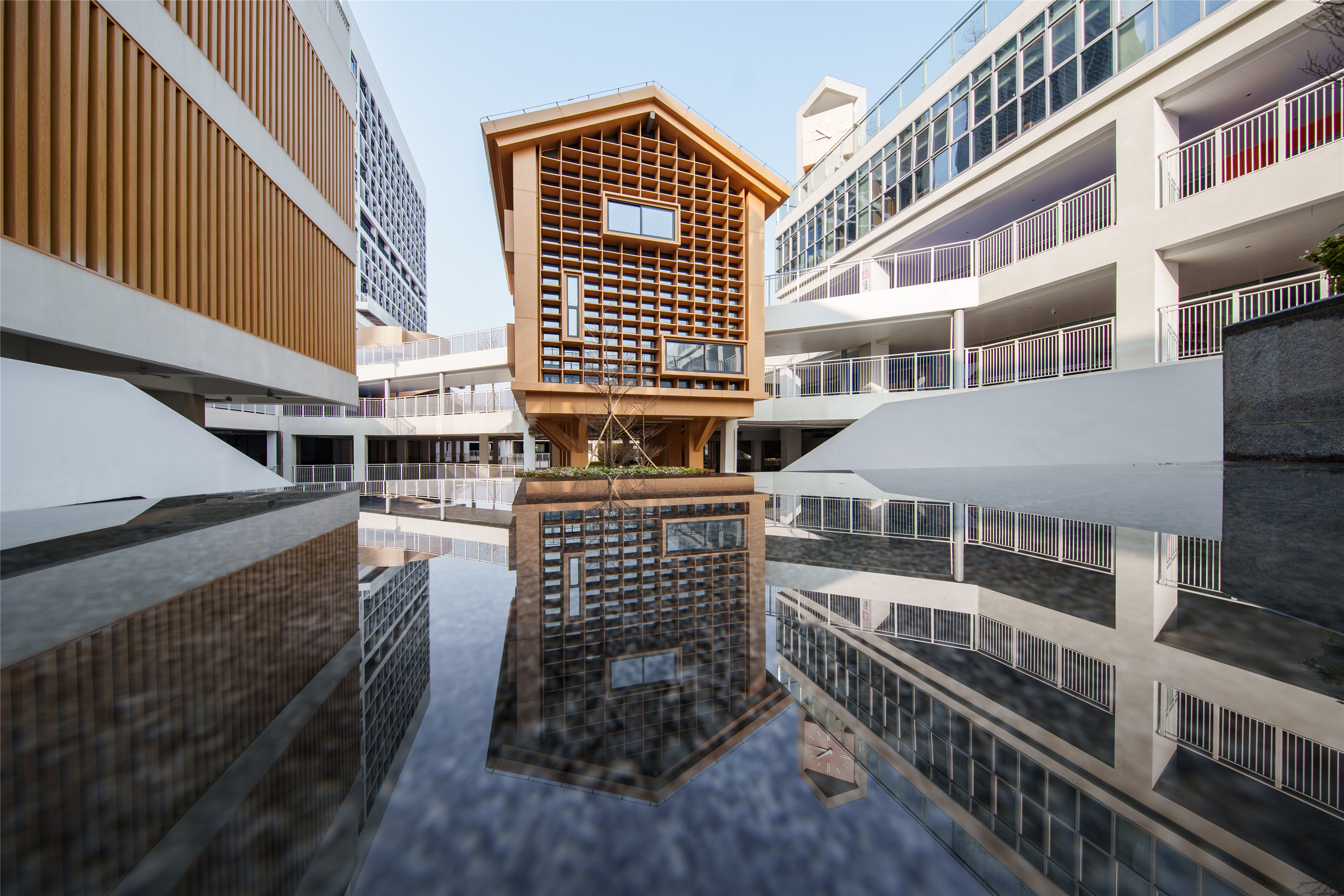
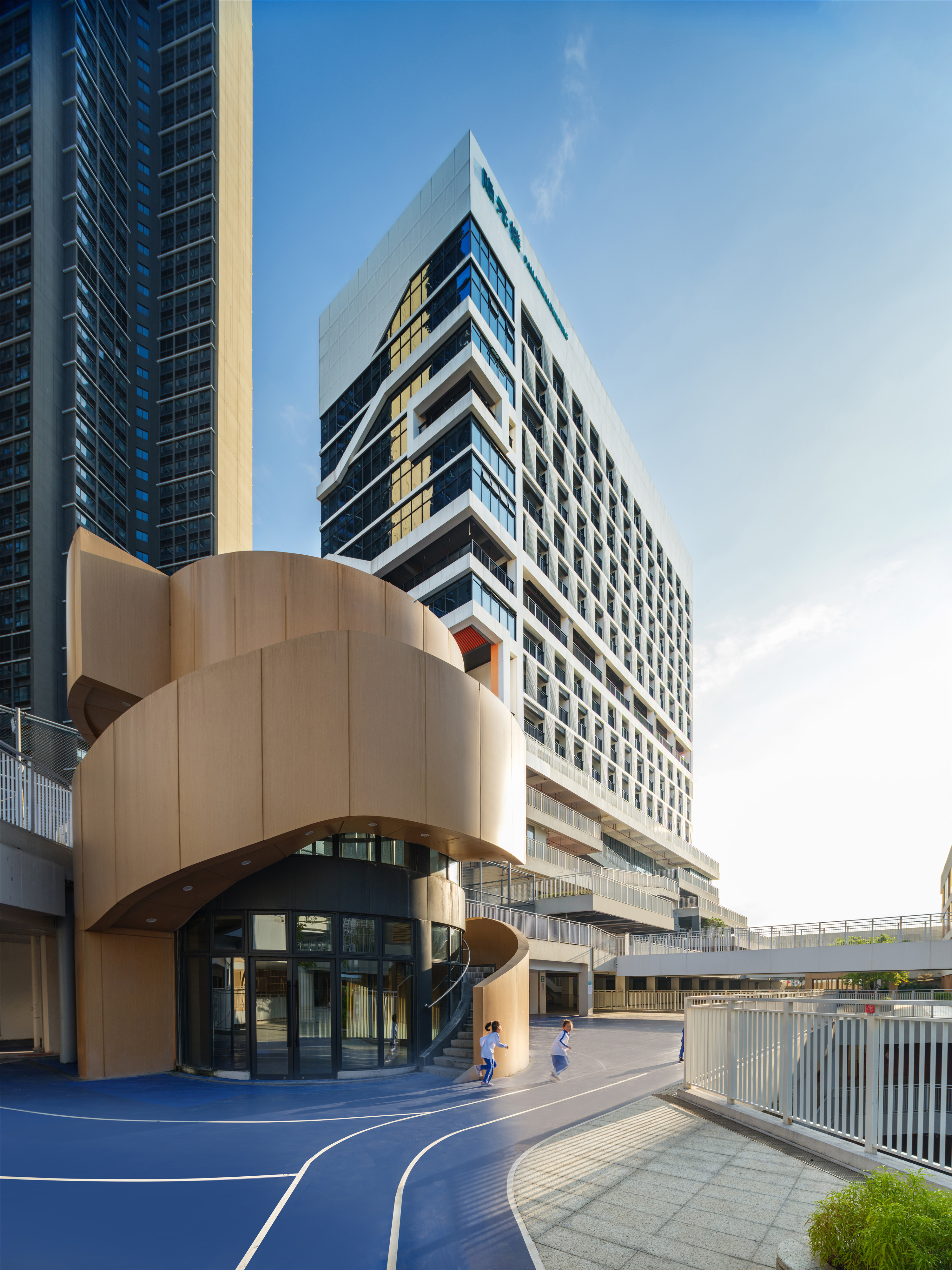
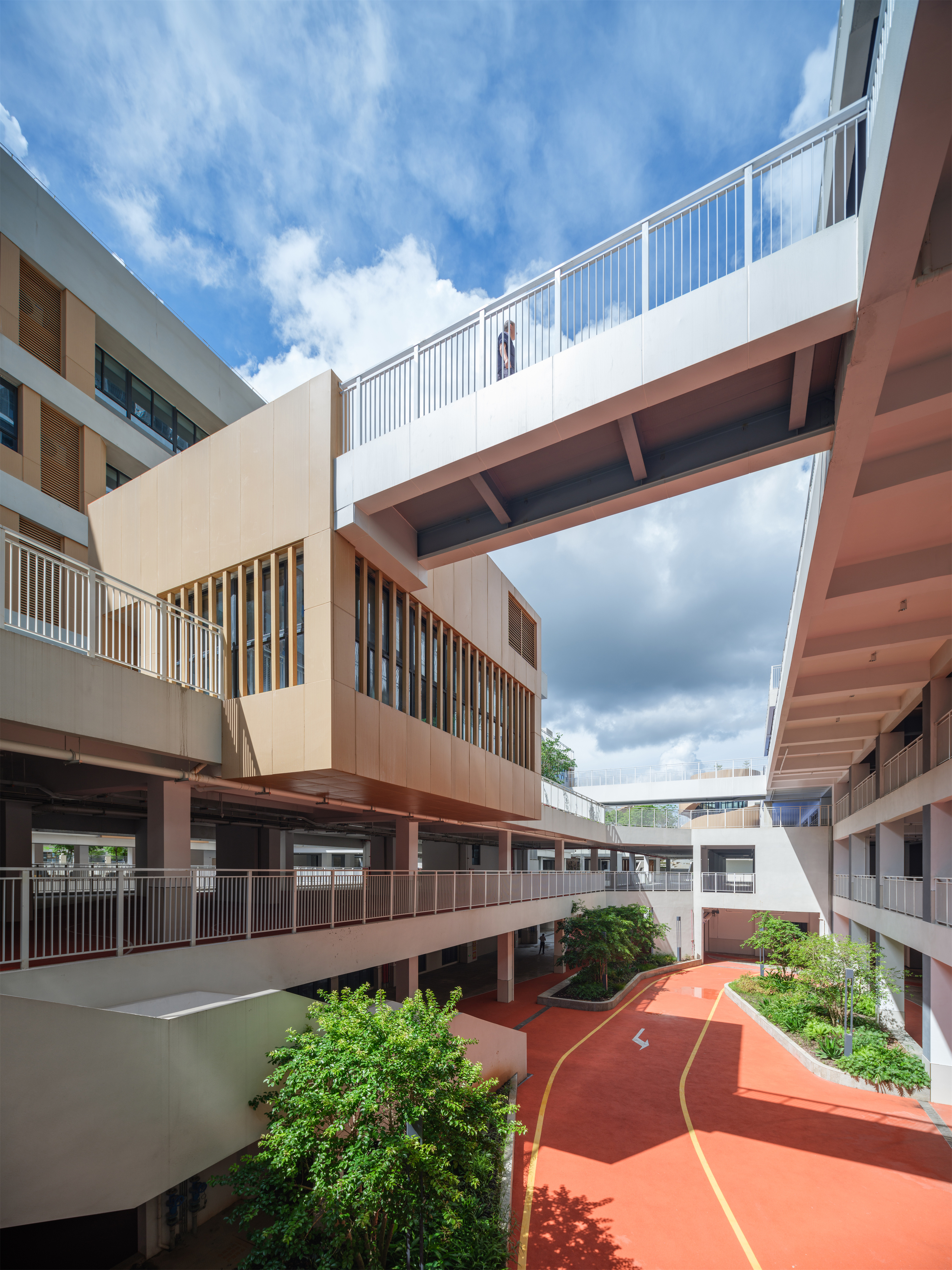
结语
叶圣陶先生曾言:“教育之要点,当天逾养成儿童正确精神之思想能力。”通过构造这样一个亦乐亦学的空间,我们希望让孩子在城市绿洲中穿行,在复合空间中游学沉思,以自然、融合、创新的场所丰富孩子们的精神世界,在未来式的建筑中享受学习生活的趣味,快乐健康地生长。
Mr. Ye Shengtao once said, "The key to education is to cultivate children's correct spiritual thinking ability on the same day." By constructing such a space that is both enjoyable and learning, we hope to allow children to travel through urban oases, learn and contemplate in complex spaces, enrich their spiritual world with natural, integrated, and innovative places, enjoy the fun of learning and living in futuristic architecture, and grow happily and healthily.

设计图纸 ▽


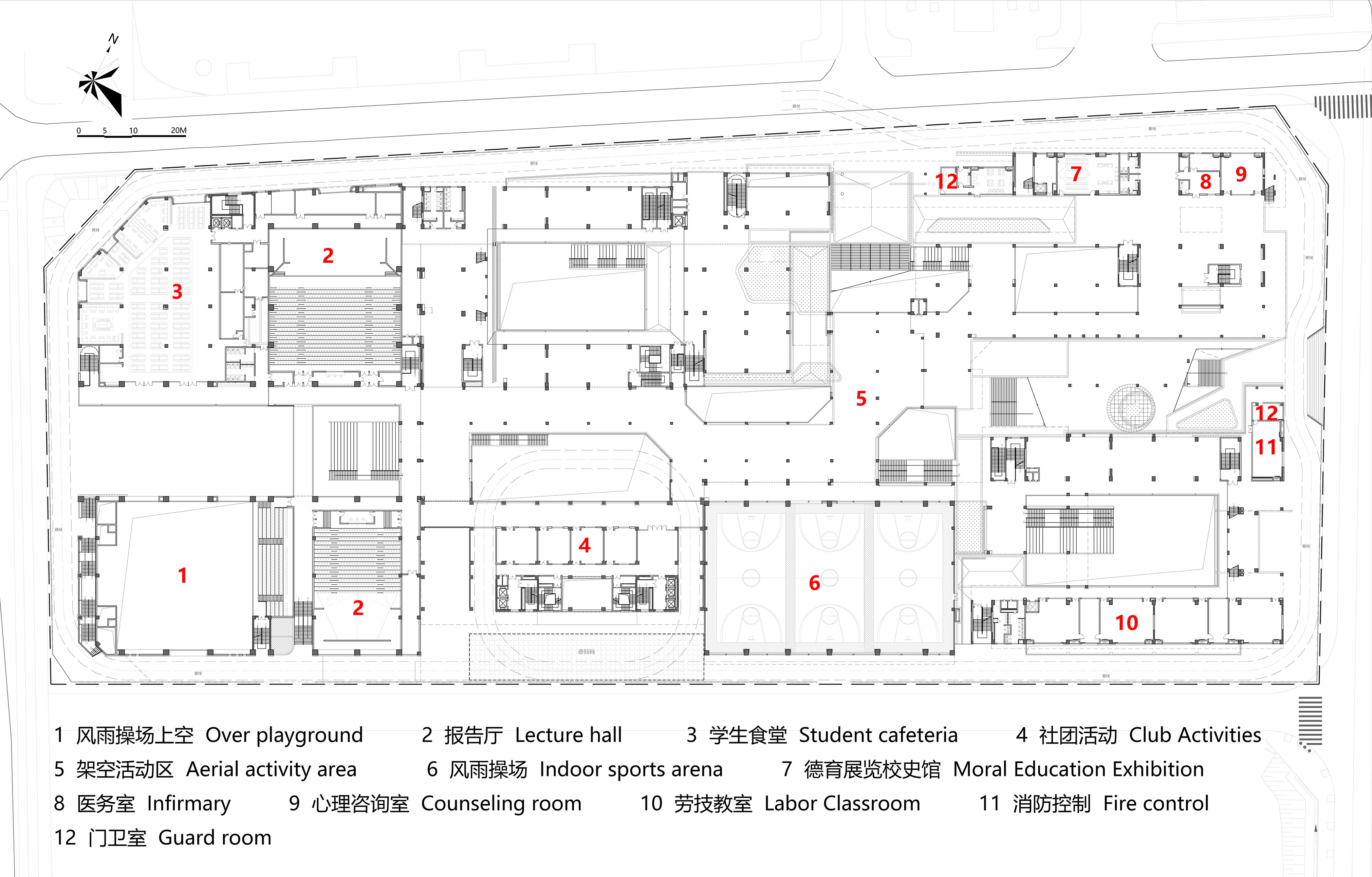
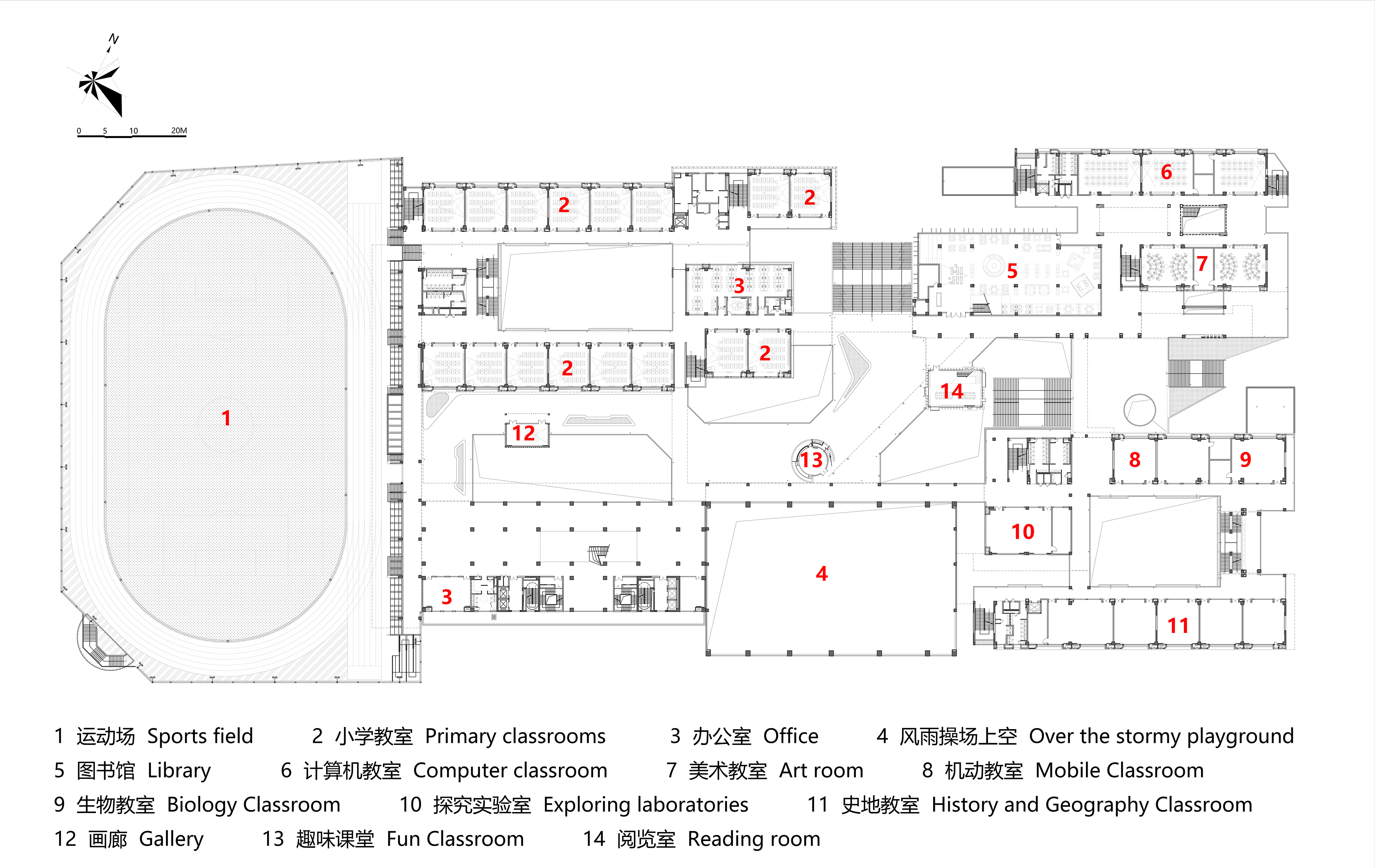

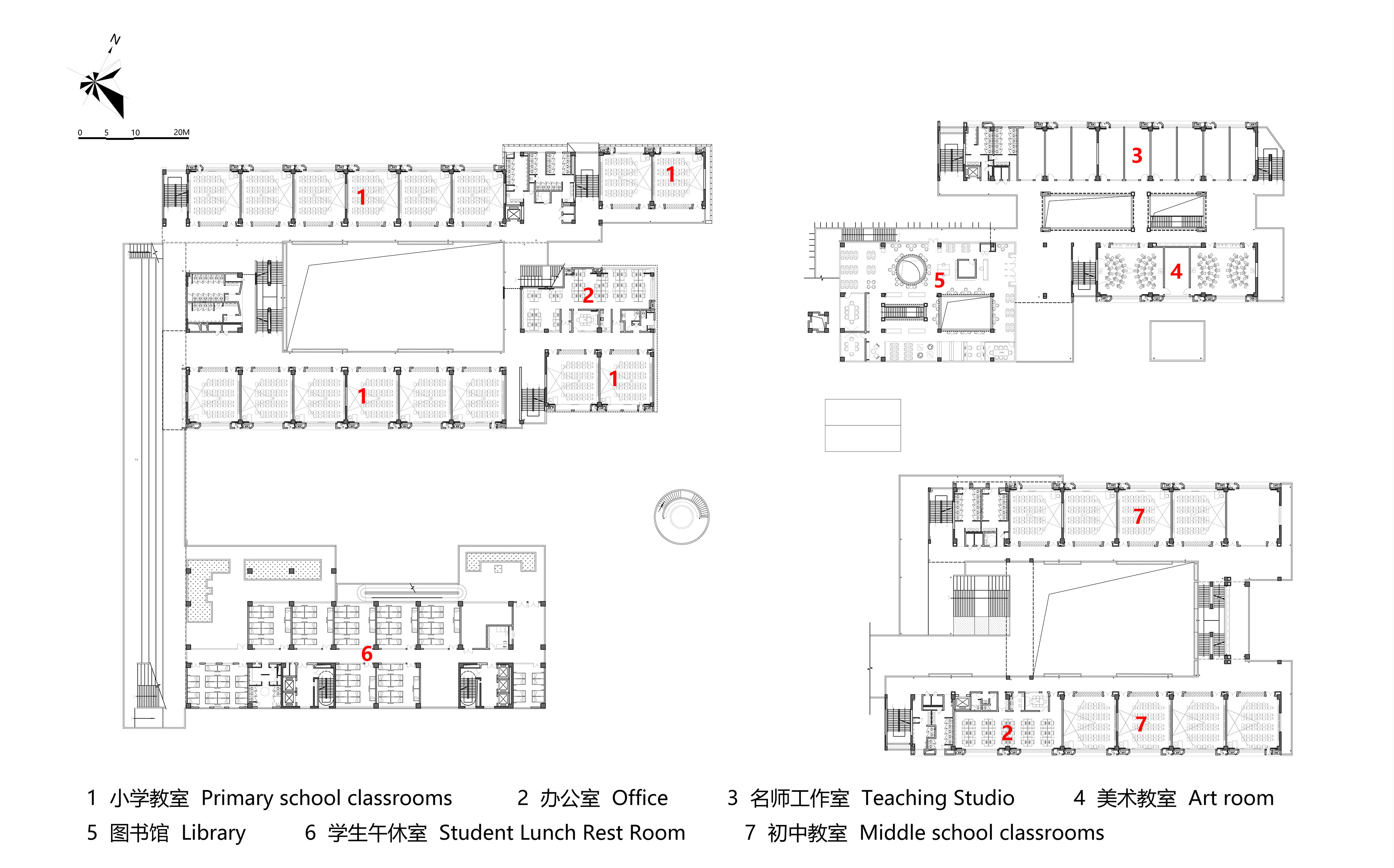

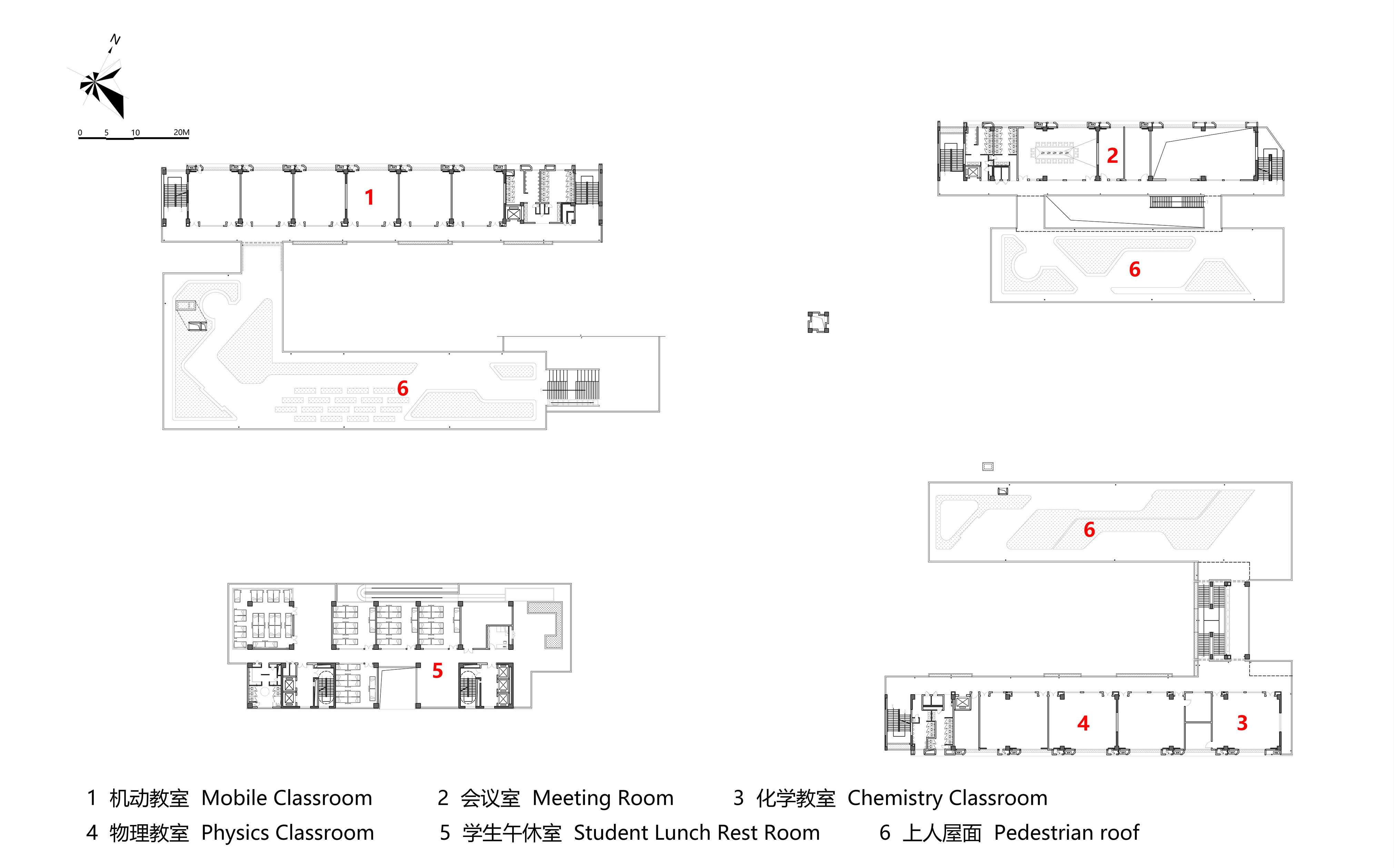
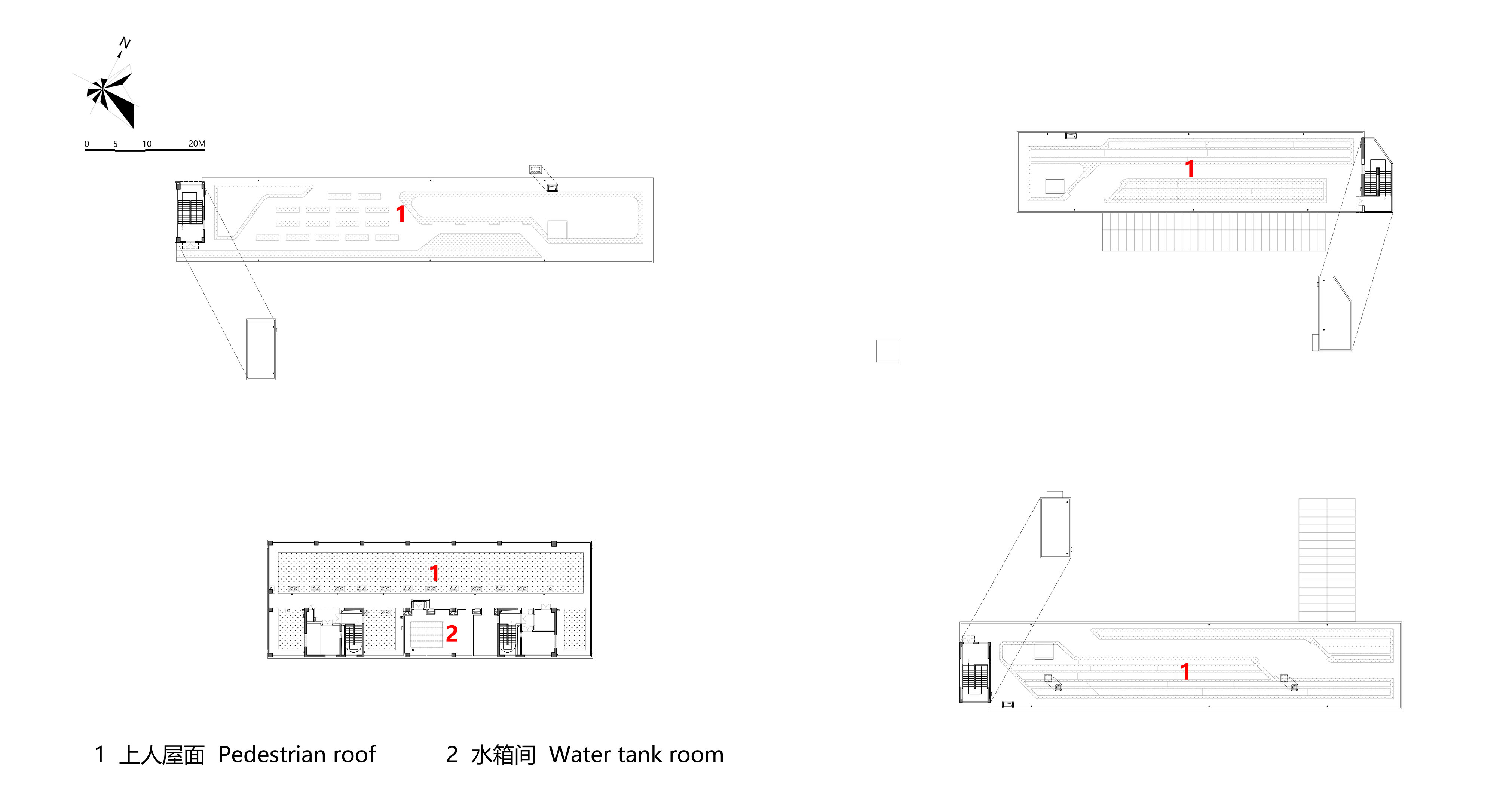
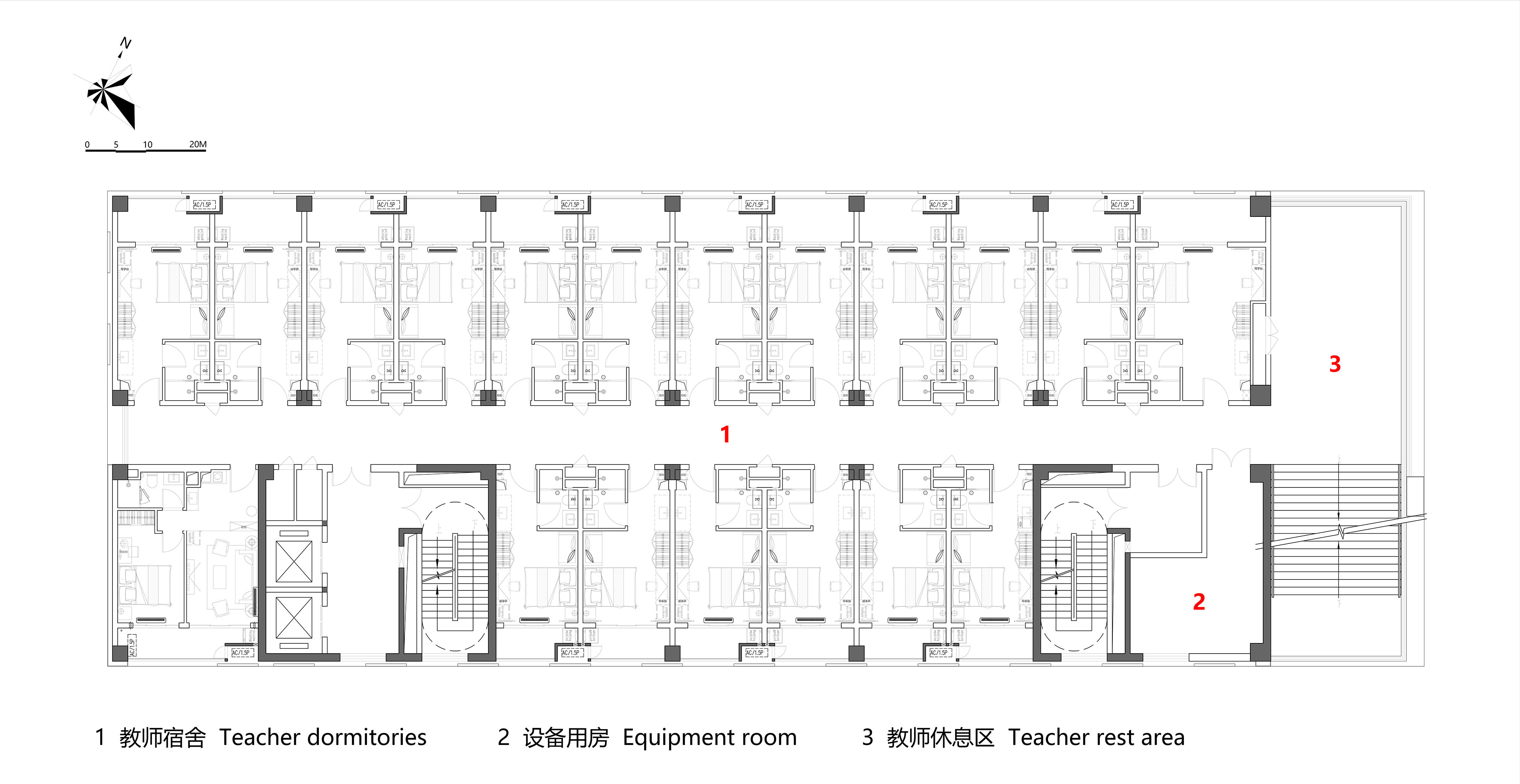
完整项目信息
项目名称:南方科技大学附属坪山学校
项目类型:建筑
项目地点:广东省,深圳市,坪山区,坑梓街道
主持建筑师:邹修洪
主创建筑师:陈木亮
执行建筑师:王宇
方案团队:张凯、何健坤、谢宗璇、黄杰辉、吕宏业、徐浩、潘英豪、王鑫、吴福堃、温
福林、谢承均、林艳
施工图负责人:陈国栋
施工图团队:陈国均、赵亚青、刘宇、万励昆、刘文涛、尚双双、杜建伟、蒋钦发
设计管理:王春培
建设单位:深圳市坪山区建筑工务署
代建单位:深圳市万科城市建设管理有限公司
设计时间:2019.5
建设时间:2022.9
用地面积:32,400平方米
建筑面积:104,107.62平方米
办学规模:72班九年一贯制
学位数量:3360个
摄影:ACF域图
版权声明:本文由申都·湾创授权发布。欢迎转发,禁止以有方编辑版本转载。
投稿邮箱:media@archiposition.com
上一篇:入围方案︱深圳市第三十六高级中学 / 中建西北院
下一篇:MAD在建方案:石家庄云朵体育中心